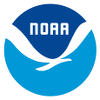Ecosystem Dynamics - Long Term Observations
Primary Investigator - Steve Pothoven - GLERL
Background
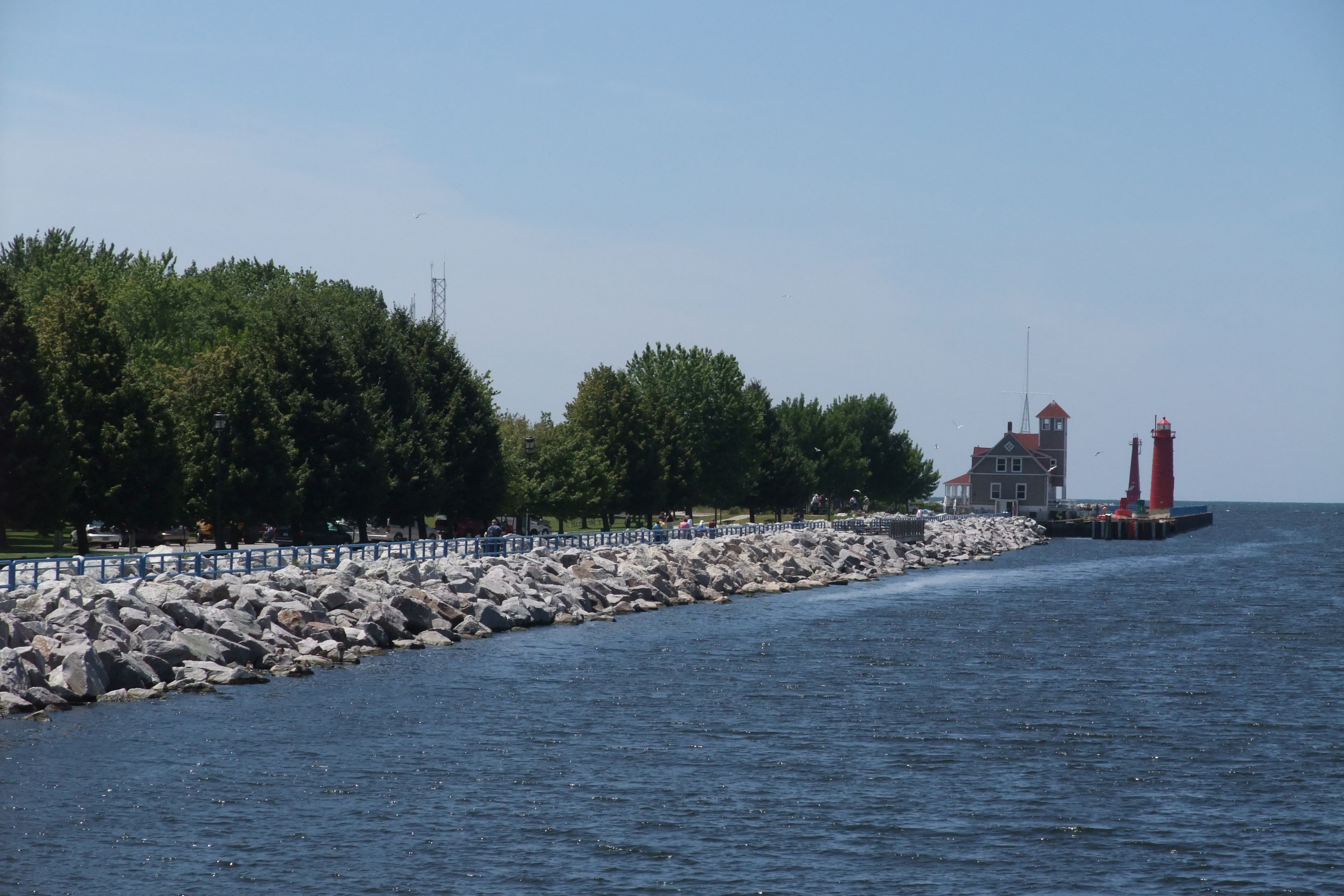
NOAA GLERL's Lake Michigan Field Station, Muskegon, Michigan. Credit: NOAA
-Nutrient loading
-Overfishing
-Pollution
-Invasive species
-Climate change
Recognizing the value of a long-term perspective on how ecosystems change over time, GLERL has invested in researching the southern basin of Lake Michigan since the 1970s. GLERL's focus on Lake Michigan has led to the establishment of the Long-Term Research (LTR) program. GLERL's LTR approach integrates a core set of long-term observations on biological, chemical, and physical variables, with short-term process-based studies for understanding ecosystem change. Such information is essential for the development of new concepts, models, and forecasting tools to explore impacts of various stressors on the ecosystem.
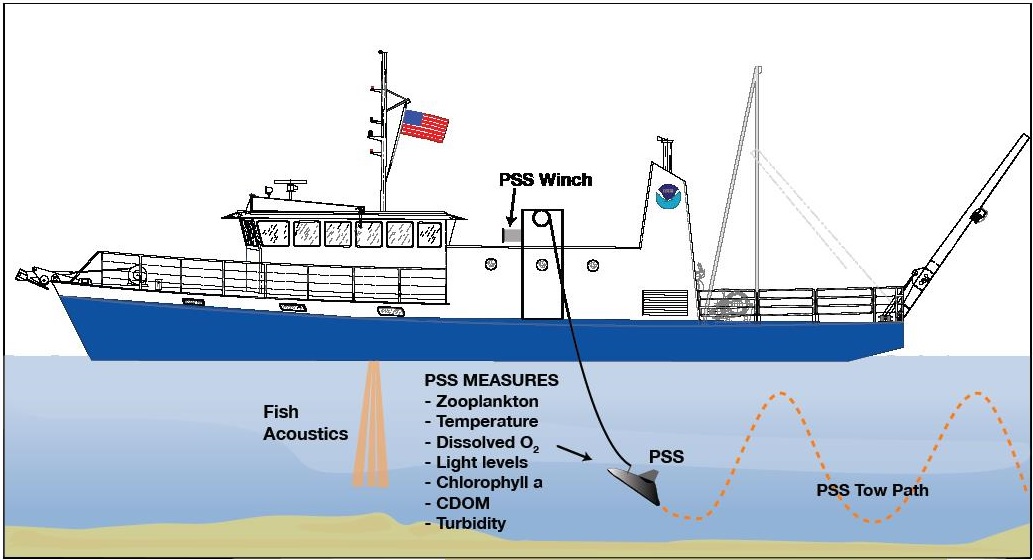
Observations on biological, chemical, and physical variables are measured using a combination of technologies on GLERL's research vessel, the R/V Laurentian. GLERL's LTR observations provide the basis for short-term process-based studies for understanding ecosystem change. Credit: NOAA.
Problem
Evidence indicates that the Lake Michigan food web is responding to a number of anthropogenic drivers related to human activity, particularly invasive species, climate change, and nutrient loading. Recently, the massive expansion of dreissenid mussel populations in Lake Michigan's deep water has been associated with the loss of the spring phytoplankton bloom and the loss of the deep chlorophyll layer, both of which are primary sources of energy for the entire offshore pelagic food web. In order to improve ecosystem management for Lake Michigan, there is a need to strengthen our understanding of how the dreissenid mussels and other invasive species impact the Lake Michigan food web.

Trawls in Lake Michigan yield a net full of dreissenid quagga mussels. Credit: NOAA
Advancing NOAA's Mission in the Great Lakes
NOAA's Ecosystems Goal is to advance our understanding of ecosystems and to improve resource management through:- Ecological characterizations that meet management needs
- Ecosystem assessments that evaluate ecological response to anthropogenic stressors
Project Goals and Objectives:
- Goal: Continue to develop our understanding of Great Lakes ecosystem processes and the impacts of various anthropogenic stressors
- Objective: Maintain long-term observations on Lake Michigan that are integrated as a core set of biological, chemical, and physical variables combined with short-term, process-based studies
- Objective: Target project results to help inform resource use and scientifically-based management decisions that lead to safe and sustainable ecosystems
- Objective: Integrate new instrumentation to more effectively monitor ecosystem conditions
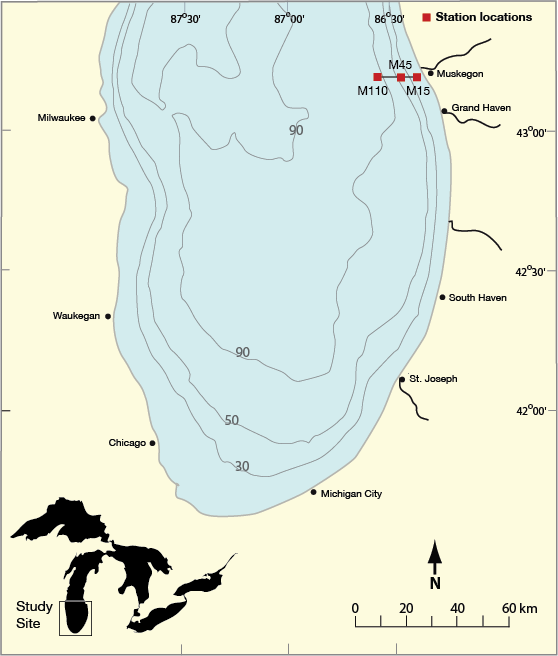
Long-term research stations in Lake Michigan are located offshore of Muskegon, Mich. at depths of 15 m, 45 m, and 110 m as shown in the figure above. Credit: NOAA.
Experimental Overview:
To better understand food web dynamics of Lake Michigan, this field effort maintains continuation of a long-term time series on key parameters in the southeast portion of the lake in the vicinity of Muskegon, Mich. This data will be collected biweekly to monthly (March-December) at stations along a nearshore (15 m) to offshore (110 m) transect. Core variables being measured include nutrients, chlorophyll, zooplankton abundance and composition, predatory zooplankton abundance, Mysis abundance, and dreissenid mussel abundance. Long-term trends in fish diets and condition are also periodically evaluated and linked to food web dynamics.As opportunity allows, GLERL researchers strive to integrate new approaches and experimental techniques into Lake Michigan's LTR program. Currently, moored instrumentation, such as thermistors and fluorometers, are being utilized at our stations, which, among other things, provide data over the winter season when other sampling is not always possible. We are also investigating incorporating new instruments such as a fluoroprobe into the sampling program, which would provide vertical profiles of phytoplankton abundance and composition.
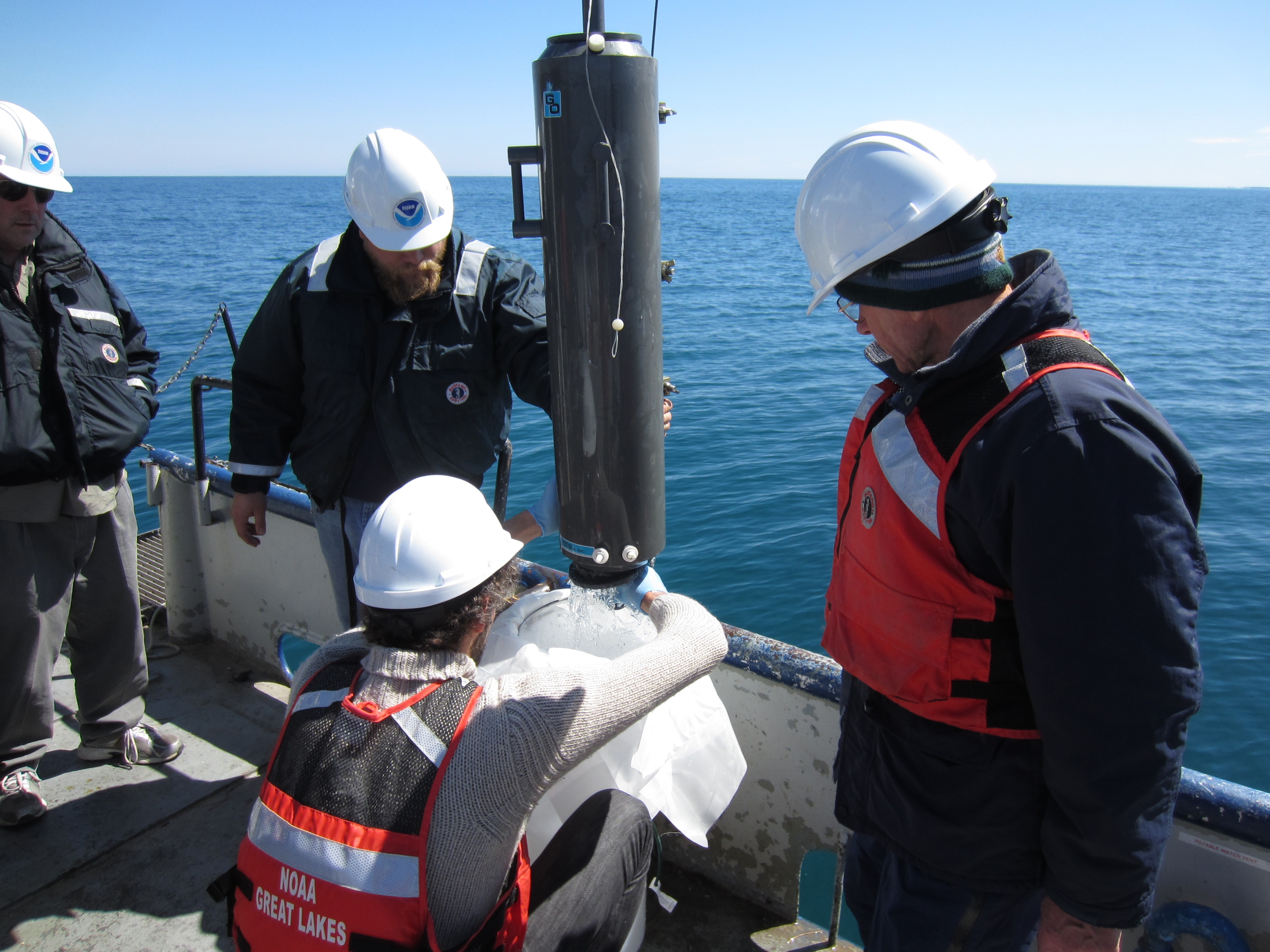
Sample collection aboard the NOAA GLERL vessel R/V Laurentian. Credit: NOAA
Project Timeline:
Ongoing since the 1970sProject Discoveries:
This project has documented some critical changes in the Lake Michigan food web including:
- A 66% decrease in spring chlorophyll concentrations between the time periods of 1995-1998 and 2007-2008
- A 93% decline in the size of-the deep chlorophyll layer between 1995-2000 and 2007-2011
- A 70% decline in Mysis abundance between 1995-2002 and 2007-2008
- Declines in lake whitefish, deepwater sculpin, and alewife condition that have been linked, in part, to food web changes including the disappearance of Diporeia, a small, shrimp-like crustacean.
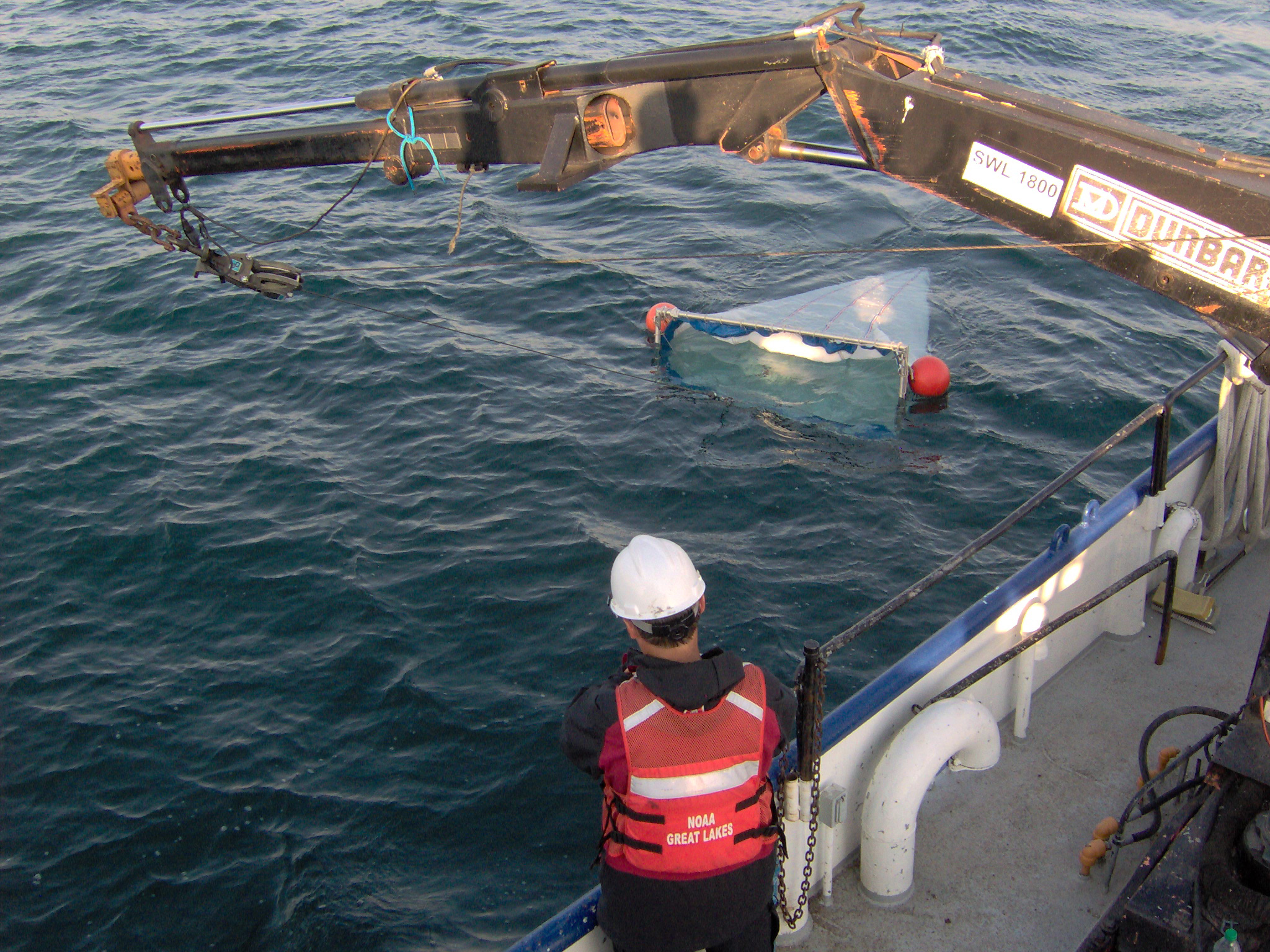
Net tows collect plankton samples in Lake Michigan. Credit: NOAA
Governmental and Societal Relevance of Research
An important objective of our research is to target project results to help inform resource use and scientifically-based management decisions that lead to safe and sustainable ecosystems, ecosystem services, and human communities. To this end, data are provided to various decision-making groups through informal discussion and through formal presentations about the status of various lower food web components and how various stressors are impacting these parameters. We also provide information to various public interest and education groups through workshops and instructional seminars in order to help promote a better understanding of food web dynamics, the role of stressors in ecosystem change, and to promote science based stewardship of Great Lakes resources. Finally, we collaborate with university partners and other agencies to leverage expertise and resources of each partner to maximize results. Data are provided to various types of groups, including:
Decision makers and policy groups
- State and federal representatives
- Great Lakes Fishery Commission
- Lake Michigan Technical Committee
- Michigan charter boat captains
- Michigan fish producers
- Michigan Sea Grant
- The Nature Conservancy
- Inland Seas
- University/Academic Partners
- USGS Great Lakes Science Center
- Michigan Department of Natural Resources
- Chippewa Ottawa Resource Authority
Featured Publications
Pothoven, S.A., and Fahnenstiel, G.L. 2013. Recent changes in summer chlorophyll a dynamics of southeastern Lake Michigan. Journal of Great Lakes Research 39:287-289.Pothoven, S.A., Fanslow, D.L., and Fahnenstiel, G.L. 2012. Lipid content of Mysis diluviana in the offshore region of southeastern Lake Michigan in 2009-2010. Journal of Great Lakes Research 38:561-568.
Pothoven, S.A., Bunnell, D.B., Madenjian, C.P., Gorman, O.T., and Roseman, E.F. 2012. Energy density of bloaters in the upper Great Lakes. Transactions of the American Fisheries Society 141(3), 772-780.
Pothoven, S.A., Vanderploeg, H.A., Warner, D.M., Schaeffer, J.S., Ludsin, S.A., Claramunt, R.M., and Nalepa, T.F. 2012. Influences on Bythotrephes longimanus life-history characteristics in the Great Lakes. Journal of Great Lakes Research 38:134-141.
Vanderploeg, H.A., Pothoven, S.A., Fahnenstiel, G.L., Cavaletto, J.F., Liebig, J.R., Stow, C.A., Nalepa, T.F., Madenjian, C.P., and Bunnell, D.B. 2012. Seasonal zooplankton dynamics in Lake Michigan: disentangling impacts of resource limitation, ecosystem engineering, and predation during a critical ecosystem transition. Journal of Great Lakes Research 38:336-352.
Pothoven, S.A., Hondorp, D.W, and Nalepa, T.F. 2011. Declines in deepwater sculpin Myoxocephalus thompsonii energy density associated with the disappearance of Diporeia spp. in Lakes Huron and Michigan. Ecology of Freshwater Fish 20:14-22.
Cavaletto, J.F., Vanderploeg, H.A., Pichlova-Ptacnikova, R., Pothoven, S.A., Liebig, J.R., and Fahnenstiel, G.L. 2010. Temporal and spatial separation allow coexistence of predatory cladocerans: Leptodora kindtii, Bythotrephes longimanus, and Cercopagis pengoi in southeastern Lake Michigan. Journal of Great Lakes Research 36(Supplement 3):65-73.
Fahnenstiel, G.L., Pothoven, S.A., Vanderploeg, H.A., Klarer, D., Nalepa, T.F., and Scavia, D. 2010. Recent changes in primary production and phytoplankton in the offshore region of southeastern Lake Michigan. Journal of Great Lakes Research 36(Supplement 3):20-29.
Fahnenstiel, G.L., Nalepa, T.F., Pothoven, S.A. Carrick, H. and Scavia, D. 2010. Lake Michigan lower food web: long term observations and Dreissena impact. Journal of Great Lakes Research 36(Supplement 3):1-4.
Mida, J.L., Scavia, D., Fahnenstiel, G.L., Pothoven, S.A., Vanderploeg, H.A., and Dolan, D.M. 2010. Long-term and recent changes in southern Lake Michigan water quality with implications for present trophic status. Journal of Great Lakes Research 36(Supplement 3):42-49.
Pothoven, S.A., Fahnenstiel, G.L., and Vanderploeg, H.A. 2010. Temporal trends in Mysis relicta abundance, production, and life-history characteristics in southeastern Lake Michigan. Journal of Great Lakes Research 36(Supplement 3):60-64.
Hook, T.O. and Pothoven, S.A. 2009. Energy content of young alewives in eastern Lake Michigan and Muskegon Lake, a connected drowned river mouth lake. North American Journal of Fisheries Management 29:378-387.
Pothoven, S.A. and Madenjian, C.P. 2008. Alewife and lake whitefish: changes in consumption following dreissenid invasions in Lakes Michigan and Huron. North American Journal of Fisheries Management 28:308-320.
Pothoven, S.A., Grigorovich, I.A., Fahnenstiel, G.L., and Balcer, M.D. 2007. Introduction of the Ponto-Caspian bloody-red mysid Hemimysis anomala into the Lake Michigan basin. Journal of Great Lakes Research 33:285-292.
Madenjian, C.P., Pothoven, S.A., Dettmers, J.M., and Holuszko, J.D. 2006. Changes in seasonal energy dynamics of alewife (Alosa pseudoharengus) in Lake Michigan after invasion of dreissenid mussels. Canadian Journal of Fisheries and Aquatic Sciences 63:891-902.
Pothoven, S.A., Nalepa, T.F., Madenjian, C.P., Rediske, R.R., Schneeberger, P.J., and He, J.X. 2006. Energy density of lake whitefish Coregonus clupeaformis in Lakes Huron and Michigan. Environmental Biology of Fishes 76:151-158.
Pothoven, S.A. 2005. Changes in lake whitefish diet in Lake Michigan, 1998-2001. In Great Lakes Fisheries Commission Technical Report 66, Proceedings, Workshop on the Dynamics of Lake Whitefish (Coregonus clupeaformis) and the Amphipod Diporeia spp. in the Great Lakes. L.C. Mohr and T.F. Nalepa (eds.), pp. 127-140. Great Lakes Fisheries Commission, Ann Arbor, MI.
Pothoven, S.A., and Vanderploeg, H.A. 2004. Diet and prey selection of alewives in Lake Michigan: seasonal, depth, and interannual patterns. Transactions of the American Fisheries Society 133:1068-1077.
Pothoven, S.A., Fahnenstiel, G.L., Vanderploeg, H.A. 2004. Spatial distribution, biomass, and population dynamics of Mysis relicta in Lake Michigan. Hydrobiologia 522: 291-299.
Pothoven, S.A., Fahnenstiel, G.L., and Vanderploeg, H.A. 2003. Population characteristics of Bythotrephes in Lake Michigan. Journal of Great Lakes Research 29:145-156.
Price, H., Pothoven, S.A., McCormick, M.J., Jensen, P.C., and Fahnenstiel, G.L. 2003. Temperature influence on commercial lake whitefish harvest in eastern Lake Michigan. Journal of Great Lakes Research 29:296-300.
Nalepa, T.F., Schloesser, D.W., Pothoven, S.A., Hondorp, D.W., Fanslow, D.L., Tuchman, M. L., and Fleischer, G.W. 2001. First finding of the amphipod Echinogammarus ischnus and the mussel Dreissena bugensis in Lake Michigan. Journal of Great Lakes Research 27(3):384-391.
Pothoven, S.A., Nalepa,T.F., Schneeberger, P.J., and Brandt, S.B. 2001. Changes in diet and body condition of lake whitefish in southern Lake Michigan associated with changes in benthos. North American Journal of Fisheries Management 21:876-883.
Pothoven, S.A., Fahnenstiel, G.L., Vanderploeg, H.A. 2001. Population dynamics of Bythotrephes cederstroemii in southeast Lake Michigan 1995-1998. Journal of Freshwater Biology 46:1491-1503
Pothoven, S.A., Fahnenstiel, G.L., Vanderploeg, H.A., and Luttenton, M. 2000. Population Dynamics of Mysis relicta in Southeastern Lake Michigan, 1995-1998. Journal of Great Lakes Research 26:357-365.

